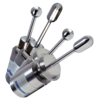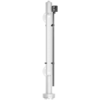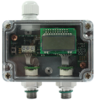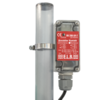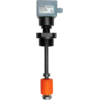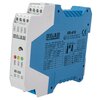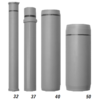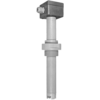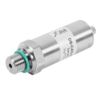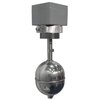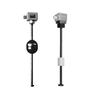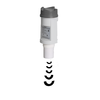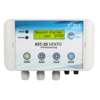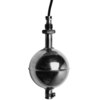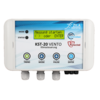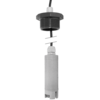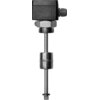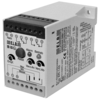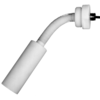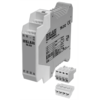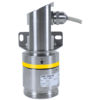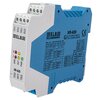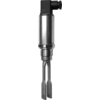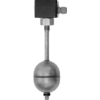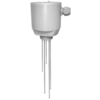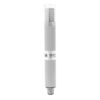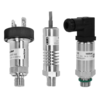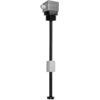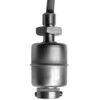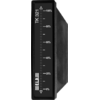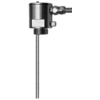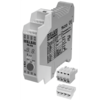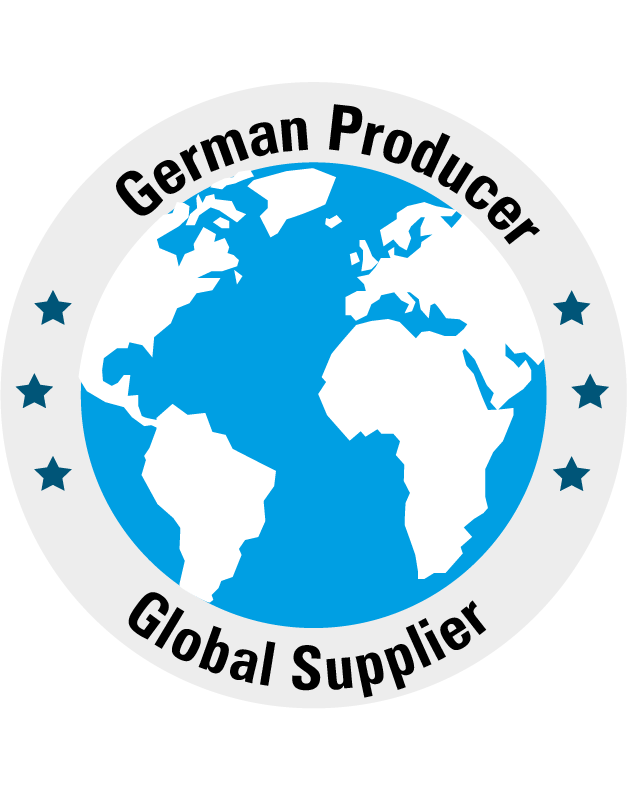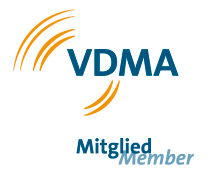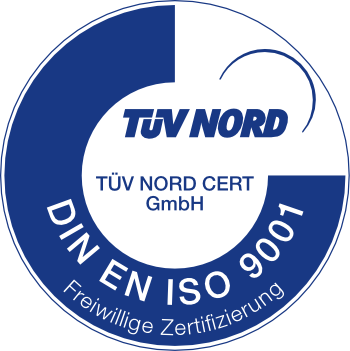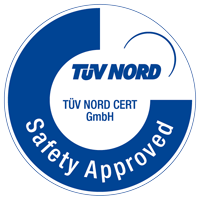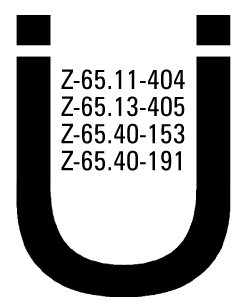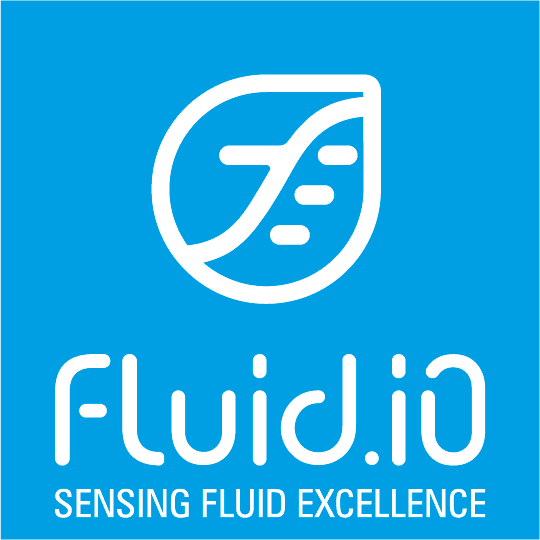Cart
product added to request
PVG-399 configure
ViscoScope® VA-100 configure
TK-307-0 configure
T-200.F Ex configure
XR-4x0 | XR-4x1 configure
PPS-390 configure
EFV2 20…230V configure
T200.F-24V configure
LU-150 configure
KST-20 Vento configure
TK-309 configure
QFS-55 configure
TK-312 configure
ZMF-202e-IR configure
XR-6x0 | XR-6x1 configure
NSP-X-E configure
TK-303 configure
EFV2 24V configure
EF 3…5 24 V configure
TK-32X configure
EE-2X configure
TK-313 configure
PVG-399
PVC weight with magnet insert and eyelet for cable fixing
for actuating monostable and bistable contacts
Variants
- 32 : Außen Ø 25 mm x 175 mm, Gewicht ca. 180 g, geeignet für Rohraußen Ø 32 u. 34 mm bis 6m Länge
- 37 : Außen Ø 30 mm x 170 mm, Gewicht ca. 180 g, geeignet für Rohraußen Ø 40 mm bis 6m Länge
- 40 : Außen Ø 40 mm x 110 mm ca. 175g, geeignet für Rohraußen Ø 50 mm bis 6m Länge
- 4012 : Außen Ø 40 mm x 110 mm ca. 300g, geeignet für Rohraußen Ø 50 mm bis 12m Länge
- 4016 : Außen Ø 40 mm x 110 mm ca. 360g geeignet für Rohraußen Ø 50 mm bis 16m Länge
- 50 : Außen Ø 50 mm x 130 mm ca. 255g, geeignet für Rohraußen Ø 63 mm bis 6m Länge
- 5012 : Außen Ø 50 mm x 130 mm ca. 300g geeignet für Rohraußen Ø 63 mm bis 12m Länge
- 5016 : Außen Ø 50 mm x 130 mm, ca. 360g, geeignet für Rohraußen Ø 63 mm bis 16m Länge
ViscoScope® VA-100
Inline Viscometer
Maintenance-free inline viscosity sensor for precise and reliable real-time measurement of viscosity directly in the process.
Properties
- Material : 1.4571 / 1.4404 (316Ti / 316L)
- Protection class : IP65
- Process temperature : -10°C … +130°C | (integriertes Pt100 im Messfühler)
- max. process pressure : Vakuum ... 64 bar
- Process connections : NPT | M48 | Varivent® | Tri-Clamp
- Cable length sensor - transmitter : Max. 1.000 Meter
- max. flow velocity : 5 m / sec
- Ex approval : II 1/2G Ex ia IIC T6...T3 Ga/Gb | (optional)
Sensor types
- Sphere : VA-100B
- Cylinder : VA-100C
Repeatability
- VA-100B : ± 0,5% | ± 1 Digit
- VA-100C : ± 0,3% | ±1 Digit
Measuring ranges
- VA-100C : 0,1 - 2.500 mPa·s x g/cm³
- VA-100B : 10 - 25.000 mPa·s x g/cm³
Probe dimensions
- VA-100C : Ø 32 x 145 mm
- VA-100B : Ø 32 x 120 mm
installation positions
- Reservoir :
- tanks :
- Pipe :
- flow cell :
- Installation is position-independent :
TK-307-0
Stainless steel level sensor for Ex-Zone 0 (Cat.1)
T30... continuous magnetic immersible probes are used for quasi-acquisition of the filling level in containers with liquid media.
General data
- Connection aluminium box : H30 x B50 x T45 mm
- Connection polyester box : H56 x B80 x T75 mm
- connection cable : 1000 mm PUR blau
- Protection class Socket : IP65
- Material Sliding tube : VA 1.4571
- Material of the angle fastening : VA 1.4408
- Sliding tube length : max. 6000 mm
- Operating temperature : max. 130 °C
- Resolution : 7,5 mm | 10 mm | 15 mm | 20 mm
- Mounting : 2 Schlauchschellen
- Accessories : R/I-Wandler TK-101
ZDT-Serie
Differential pressure transmitter for high or low pressure applications
Versatile and reliable differential pressure transmitter for measuring air, non-aggressive media as well as liquids and oils.
Properties
- Pressure type : Differenzdruck
- Housing : Kunststoff
- LCD display : optional
- Signal output : 0…10 V | 4…20 mA
Measurement parameters
- Total error : ± 2,5 % FS (typ. ± 0,5 %)
- Linearity error : ± 1 % FS
Operating conditions
- Operating temperature : 0...+50 °C
- Storage temperature : -20°C...+120°C
BK-3X0
Bistable change-over contact
Magnetically actuated changeover switch,
which permanently changes its electrical switching state as a result of a magnetic system passing by, depending on the direction of movement.
Properties
- Protection class EN60529 : IP 65
- Operating temperature : –25...+70 °C
- Wire cross-section max. : 1,5mm²
- Switching point distance between two contacts : min. 40 mm
- Switching hysteresis : ca. 10-15 mm
Material
- Housing : Polycarbonat
- Mounting clip : V2A, Kabelbinder (PP)
- Rivet : V2A
- Screw connection : M 20 x 1.5, Polyamid
Weight
- BK-390-50 : 137 g
- BK-390-63 / BK-380 : 140 g
Switching contact
- Switching voltage : 5...250 V AC/DC
- Switching current : 1mA...6 A AC/DC
- Switching capacity(min.) : 300 VA, 60 W
- Switching capacity(max.) : 5 mW
T-200.F Ex
Overfill protection for containers with Ex approval
Level sensors type T-20_.F... are
approved by the DIBt (German
Institute for Structural Engineering) as liquid level limit switches for the overcharge protection of containers for storing water-dangerous liquids.
Connection
- Box : Ex-Polyester
- Box : Ex-Aluminium
Properties
- Protection class EN60529 : IP 65
- connection thread : G2"
- Union nut : G 2¾"
- Guide tube length : max. 6 m
- Operating temperature : -20…+60 °C
- Operating pressure : max. 6 bar je nach Ausführung
- media density : ρ ≥ 0,72 g/cm³ (je nach Schwimmertyp)
- Switching hysteresis : 2 mm
- Switching point tolerance : max. 2 mm
Resistance value
- Operational readiness : ca. 1 kΩ
- overfill alarm : ca. 12 kΩ
- Switching time : ca. 20 ms
- Ex-protection : siehe Baumusterprüfbescheinigung
- CE marking : siehe Konformitätserklärung
XR-4x0 | XR-4x1
Electrode relay with ATEX
The electrode relays are used for conductive level detection.
levels. The possible applications extend
areas where conductive, liquid media are to be detected, controlled
to be detected, controlled or regulated. Hereby
level detection (overflow / dry run) as well as minimum / maximum
as well as minimum / maximum controls can be realised.
Protection class EN60529
- clamp : IP20
- Housing : IP40
Technical Data
- Operating temperature : -20...+60 °C
- Storage temperature : -30...+80 °C
- Output contacts : potentialfrei
- Switching voltage : min. 5 V | max. 250 V AC / 150 V DC
- Switching current : min. 5 mA | max. 5 A AC / 5 A DC
- Switching capacity : min. 300 mW | max. 100 VA / 50 W
- Quiescent current : umschaltbar
- Weight : ca. 250 g
- CE marking : siehe Konformitätserklärung
- Ex-protection/IECEx : siehe Prüfbescheinigung
PPS-390
PPH float with magnet insert
for actuating monostable and bistable contacts
Variants
- 32 : AußenØ 26 x 180 mm, für RohraußenØ 32 u. 34 mm Gewicht ca. 38 g
- 37 : AußenØ 29,5 x 170 mm, für RohraußenØ 40 mm (PN 16) Gewicht ca. 62 g
- 40 : AußenØ 40 x 165 mm, für RohraußenØ 50 mm Gewicht ca. 145 g
- 50 : AußenØ 50 x 125 mm, für RohraußenØ 63 mm Gewicht ca. 156 g
EFV2 20…230V
Conductive electrodes with 24...230 V direct connection
The overfill protection EFV2 (24...230 V AC/DC) is approved by the "DIBt" as overfill protection for liquids hazardous to water.
Properties
- connection : Polyesterdose (PO)
- Protection class : IP 65
- connection thread : G2"
- Union nut : G2¾" | S 100x8
- Material Screw connection : PE, PVC, PPH, PVDF
- Material Sensor rods : Edelstahl (1.4571), Hastelloy B, Hastelloy C, Titan, Tantal, Kohlestifte
- Operating pressure : atmosphärisch
- Resistance value of line monitoring : 100 kΩ
- Adjustable sensitivity range : 2..100 kΩ
Operating temperature
- PE : atmosphärisch
- PVC : atmosphärisch
- PPH : 90 °C
- PVDF : 100 °C
Power supply
- nominal voltage : 24...230 V AC/DC
- Power consumption : ≤ 2 W
Output
- potential-free changeover contacts : 2
- Switching voltage : max. 250 V AC / 30 V DC
- Switching current : max. 5 A AC / 5 A DC
- Switching capacity : max. 750 VA / 90 W
- displays : Betriebs- LED grün Funktions-LED rot
- Switching delay : ca. 0,5 s
DS-CAN-01
CANopen pressure transmitter with CAN bus signal output
Versatile, media-compatible pressure transmitter with CAN bus interface.
technical properties
- Pressure type : Relativdruck gegen Umgebungsdruck bzw. gegen interne Atmosphäre
- measuring resolution : 10 Bit
- Measuring accuracy : Klasse 0,5 bei RT
- Total error : < 1,5 % v.E bei -10 °C … +80 °C.
- measuring grid : ab 5 ms
- CAN protocol : CANopen 2.0 A
- Physical Layer : nach DIN 11898
ambient conditions
- Operating temperature range : -40 °C … +80 °C
- Storage temperature range : -40 °C … +120 °C
- Shock resistance : 30 g, Dauer
- Vibration resistance : 10 g bei 20-1000 Hz
- EMC/ESD : EN 50082-1 und EN 50082-2
- Duration : 14 ms bei RT
Pressure measuring ranges
- kPa : bar
- 0...500 : 0…5
- 0...1.000 : 0…10
- 0...2.000 : 0…20
- 0...5.000 : 0…50
- 0...10.000 : 0…100
- 0...35.000 : 0…350
- 0...50.000 : 0…500
- 0...70.000 : 0…700
- 0...200.000 : 0…2.000
- 0...400.000 : 0…4.000
- Standard pressure range : in kPa
- Non-standard ranges : auf Anfrage erhältlich
T203.F
Overfill protection for containers
Level sensors type T-20_.F... are
approved by the DIBt (German
Institute for Structural Engineering) as liquid level limit switches for the overcharge protection of containers for storing water-dangerous liquids.
Properties
- Protection class : IP 65 Dose
- Sliding tube length : max. 6000 mm
- Operating temperature : max. 135 °C
- Operating pressure : max. 20 bar
- F-Contact : 1/12 kΩ
- Switching current : 1A, 2A
- Switching voltage : 230 V AC
Float
- quantity : max. 6
- Type 05 : Oval Edelstahl 76 mm Ø | Dichte 0,81 g/cm³
- Type 06 : Oval Edelstahl 90 mm Ø | Dichte 0,67 g/cm³
- Minimum contact distance : Typ 05: 110 mm | Typ 06: 135 mm
Switching contacts and switching capacity
- Changeover contact : max. 5x | 60 W/VA
- normally open : max. 6x | 100 W/VA
- Normally closed contact : max. 4x | 60 W/VA
T-20X
Immersible Magnetic Probe made of PVC, PE, PPH, PTFE or stainless steel (1.4571)
Magnetic immersion probes for use with highly aggressive liquid media for detecting level limits in containers
Properties
- connection : Polyesterdose | Aluminiumdose
- Protection class EN60529 : IP 65 Anschlussdose
- Connector plug : 3- und 6-fach
- connection thread : G 1/8" | G 3/8" | G 1/4" | G 1/2" | G 1" | G1 1/4" | G1 1/2" | G2" | G3"
- connection cable : LiYY max. 80 °C | PTFE-Litze, 0,24 mm² | Silikon max. 150 °C
- Sliding tube length : max. 1000 mm (Rohr Ø 8 mm) | 6000 mm
- Operating pressure : max. 20 bar
- Viscosity : < 100 cp
- Protection class EN60529 : IP 68 Führungsrohr
- Switching voltage : max. 250 V
- Switching hysteresis : ca. 2...5 mm
- Holding range : ca. 12 mm
- Contact function : monostabil | bistabil
Operating temperature
- ltdata. : max. +60...+150 °C
- ltdata. : min. –20... –10 °C
- ltdata. : höhere oder niedrigere Temperaturen auf Anfrage
Switching capacity
- Changeover contact : 60 W/VA
- normally open : 100 W/VA
- Normally closed contact : 60 W/VA
Switching current
- Changeover contact : max. 1 A
- NO/NC contact : max. 2 A
Contacts
- Changeover contact : 8
- normally open : 10
- Normally closed contact : 7
T200.F-24V
Overfill protection with 24V direct connection
Level sensors type T-20_.F... are
approved by the DIBt (German
Institute for Structural Engineering) as liquid level limit switches for the overcharge protection of containers for storing water-dangerous liquids.
Connection
- Polyester junction box : PO/ET-520
- Polyethylene connection head : PE/ET-521
Properties
- Protection class EN60529 : IP 65
- connection thread : G 1", G 1¼", G 1½", G2", G3”
- Union nut : G 2¾", S 100x8
- Guide tube length : max. 6 m
- Operating temperature : max. 80 °C
- Operating pressure : atmosphärisch
- media density : ρ ≥ 0,6 g/cm³ (je nach Schwimmertyp)
- Switching hysteresis : typ. 2 mm
- Switching point tolerance : max. 2 mm
Power supply
- nominal voltage : 24 V DC (24…300V DC)
- Power consumption : ≤ 1 W
Output
- Output contact : 1 potentialfreier Wechselkontakt
- Switching voltage : max. 250 V AC / 30 V DC
- Switching current : max. 3 A AC / 3 A DC
- Switching capacity : max. 750 VA / 90 W
Optocoupler
- Switching voltage : max. 30 V
- Switching current : max. 100 mA
- displays : Betriebs-LED grün, Funktions-LED rot
- Switching delay : ca. 0,5 s Anzug/Abfall
LU-150
Compact Ultrasonic Level Sensor
The LU-150 is a short-range integrated ultrasonic level transmitter, intrinsically safe as Ex-version LU-180. This general purpose, 2 wire, 4 to 20 mA loop powered transmitter is ideal for liquids, slurries, and bulk materials in open or closed vessels to 5 m (16.4 ft).
Properties
- Protection class EN60529 : IP 68
- Power supply : 12...30 V DC / 0.1A Spitze
- Power consumption : Max. 0,75 W (25 mA bei 24 V DC)
- Output : 4...20 mA
- Max. Load : 600 Ω bei 24 V DC
- Measuring span : Proportional oder umgekehrt proportional
- Measurable materials : Flüssigkeiten, Schlämme, Schuttgüter
- operating temperature : –20...+60 °C
- Opening angle : 12°
- working pressure : Atmosphärisch
- Display : 3-stelliges LCD
- Process connection : Gewinde G 2" (BSPP) EN 10226 PVDF
- Weight : 1,3 Kg
- Cable entry : Kabelverschraubung M 20 x 1.5
- Material housing electronics : Polybutylenterephthalat PBT
- Material sensor / thread : PVDF-Copolymer
Input
- Measuring range : 0,25...5,0 m
- frequency : 54 kHz
Measuring Accuracy
- Measurement deviation : ± 0,25 % vom Messbereich (in Luft)
- Resolution : 3 mm
- Temperature compensation : im Sensor integriert
- Echo processing : „Sonic Intelligence“ von Siemens
KST-20 Vento
Automatic, controlled ventilation and dehumidification as well as cooling of rooms with aH-Controlled technology*.
The KST-20 Vento is a climate control unit with aH-Controlled technology for ventilation, dehumidification and cooling for all types of private, commercial and industrial rooms. With the three operating modes for ventilation, dehumidification and cooling, the KST-20 Vento climate control can be used flexibly in almost all living, working and industrial areas.
Properties
- Power supply : 230 V AC
- Protection class : IP 65
- Dimensions (LxBxH) : 160 x 90 x 50 mm
- Housing : hochwertiges ASA+PC (UL 94 V-0) für harte Beanspruchung, flammwidrig und selbstverlöschend
- Signal output : I²C
Measuring range
- measuring range (Humidity) : 0…100% rF,
- Measuring accuracy (humidity) : ±2%
- measuring range (Temperature) : -40…+80°C
- Measuring accuracy (temperature) : ±0,2°C
TK-309
Stainless steel level sensor
T30... continuous magnetic immersible probes are used for quasi-acquisition of the filling level in containers with liquid media.
Technical Data
- connection : Dose
- Protection class socket / plug : IP 65
- Protection class EN60529 cable : IP 55
- Float type : 07
- connection cable : 1000 mm Silikon 0,5 mm²
- Sliding tube length : max. 6000 mm
- Operating temperature : max. 130 °C
- Operating pressure : max. 20 bar
- media density : Typ 07: 0,54 g/cm³
- Resolution : 7,5 mm | 10 mm | 15 mm | 20 mm | 1% | 2% | 5%
- Accessories : R/I-Wandler TK-101
KST-20 Vento-RN
Climate control with aH-Controlled technology and Rn-Protected seal
The KST-20 Vento/RN is a climate control unit with aH-Controlled technology and Rn-Protected seal for ventilation and dehumidification of all types of private, commercial and industrial rooms. With the three operating modes for ventilation, dehumidification and radon measurement, the KST-20 Vento climate control unit can be used flexibly in almost all living, working and industrial areas.
Properties
- Power supply : 230 V AC
- Protection class : IP 65
- Dimensions (LxBxH) : 160 x 90 x 50 mm
- Housing : hochwertigem ASA+PC (UL 94 V-0) für harte Beanspruchung, flammwidrig und selbstverlöschend
- Signal output : I²C
Measuring range
- measuring range (Humidity) : 0…100 % rF
- Measuring accuracy (humidity) : ±2 %
- measuring range (Temperature) : -40…+80 °C
- Measuring accuracy (temperature) : ±0,2 °C
- measuring range (radon) : 0...1200 Bq/m³
- Adjustable limits : 80...1000 Bq/m³
ELH
Suspension electrode as leakage probe
The leakage probes of the type series ELH are approved by the "DIBt" for the monitoring of collecting chambers, collecting devices, inspection and filling shafts.
General data
- Protection class : IP 68
- Probe body material : PE, PVC, PPH, PVDF
- Diameter probe body : 15 mm, 25 mm, 40 mm
- Operating temperature : atmosphärisch
- Operating pressure : atmosphärisch
- Resistance value of line monitoring : 22 kΩ / 100 kΩ
Material
- Screw connection : PVDF
- Cable : TPK ( PVC Basis)
- on request : FEP (Teflon), PVC - blau
- cable length : auf Wunsch (Standard 3 m)
- Material Sensor rods : Edelstahl (1.4571), Hastelloy B, Hastelloy C, Titan, Tantal, Glas-Kohlestifte
T204.F
Immersible Magnetic Probes Ex area zone 0 (Cat 1)
Properties
- connection : Polyester Dose | Aluminium Dose
- Protection class : IP 65 Dose
- number of floats : max. 4x
- Operating temperature : max. 135 °C
- F-Contact : 1 / 12 kΩ
- Number of additional contacts : max. 3x Wechsler | 5x Schließer | 3x Öffner
- Switching current : 1 A, 2 A (nur mit Schirmung)
- Switching voltage : 230 V AC
Float
- Stainless steel ball 52mm Ø : max. 20 bar | 0,75 g/cm³
- Stainless steel ball 61 mm Ø : max. 20 bar | 0,65 g/cm³
- Stainless steel cylinder 44 mm Ø : max. 15 bar | 0,76 g/cm³
- min. contact gap type 03 : 75 mm
- min. contact gap type 04 : 85 mm
- min. contact gap type 09 : 75 mm
Switching contacts and switching capacity
- Changeover contact : max. 3x | 60W/VA
- normally open : max. 5x | 100 W / VA
- Normally closed contact : max. 3x | 60 W/VA
ER-Serie
Electrode Relays
Electrode relays for conductive level detection for all areas in which conductive, liquid media are to be detected, controlled or monitored
Properties
- details : folgen
QFS-55
Teflon float switch in rod design
The float switch combination is built with float switches of the QFS-50 and QFS-60 series. This makes it possible to control a level in a simple way.
Technical Data
- Material : PTFE (Teflon)
- connection cable : Silikon, Teflon
- Material rod : VA-Rohr, PTFE beschichtet
- Operating temperature : max. +150 °C
- media density : ρ ≥ 0,75 g/cm³
- Switching system : Reed-Schalter
- Contact : Wechsler, NO, NC
- Inductive/capacitive loads : Unbedingt Kontaktschutz vorsehen
- Ex-protection optional : Elektrische Daten siehe EG-Prüfbescheinigung IBExU10ATEX 1089
Reed contact
- Switching current : 1 mA ... 1 A
- Switching voltage : 24 ... 250 V AC/DC
- Switching capacity : Max. 1A, 60 VA / 60 W
- Switching hysteresis : ca. 100 mm
- Switching angle : ca. +20°...–20°
Namur circuit (1kΩ/12kQ)
- Switching current / switching voltage : nur zum Anschluss an KR-163... oder andere „Namur”-Relais
- Switching hysteresis : ca. 100 mm
- Switching angle : ca. +20°...–20°
TK-312
Evaluation unit with 0/4... 20 mA current output
The TK-312 measuring transducer converts the resistance signal supplied from a continuous level sensor into a current signal proportionate to the level.
Properties
- Protection class EN60529 clamp : IP 20
- Protection class EN60529 front panel housing : IP 40
- Operating temperature : –20...+60 °C
- nominal voltage : 24... 230 V AC/DC
- Power consumption : 2 VA, 2W
- Dimensions housing type B : 22,5 x 114,5 x 99
- Dimensions housing type C : 22,5 x 114,5 x 114
Input
- Voltage : 0...10 V
- Resistance in three-wire circuit RG : 0-4...10 kW
Output
- Temperature influence tolerance : max. ± 0,6 % der Signalspanne
- Current output : 0/4... 20 mA bezogen auf die Masse des Eingangs
- Voltage output : 0/2... 10 V
- Mounting : Tragschiene nach EN 50022
- Weight : 175 g
ZMF-202e-IR
Robust propane gas sensor for industrial applications with extended operating temperature range and ATEX / SIL-2
The ZMF-202e-IR is a propane sensor for measuring propane concentration in harsh environments.
Properties
- Operating conditions : -40 °C…+60 °C
- Storage conditions : -40 °C…+85 °C
- RelativeHumidity : 0…95 % nicht kondensierend
- Measurement method : NDIR (dual beam technology)
- Certification : SIL2, ATEX
- Signal output : 4..20mA
- Power supply : 12…24 V DC
- Housing : Edelstahl
- Standard cable length : 1,5 m
- pressure conditions : 800...1200 mbar
- screw thread : M46x1,5
Measuring ranges
- in ppm : in vol%
- 0...17.000ppm : 0…1,7 vol% (100 % LEL)
- 0...21.000ppm : 0…2,1 vol%
Options
- Other cable lengths on request :
- ATEX certification (optional) :
XR-6x0 | XR-6x1
Contact protection relay Measuring transducer
The contact protection relays are universal measuring transducers, which
input signals (resistance values) with "Namur" specification (DIN EN 60947).
Namur" specification (DIN EN 60947) into switching signals of floating
output contacts.
Protection class EN60529
- clamp : IP20
- Housing : IP40
Technical Data
- Operating temperature : -20...+60 °C
- Storage temperature : -30...+80 °C
- Output contacts : potentialfrei
- Switching voltage : min. 5 V, max. 250 V AC / 150 V DC
- Switching current : min. 5 mA, max. 5 A AC / 5 A DC
- Switching capacity : min. 300 mW, max.100 VA / max. 50 W
- CE marking : siehe Konformitätserklärung
- Ex-protection/IECEx : siehe Baumusterprüfbescheinigung
- Weight : ca. 170 g
- Quiescent current : umschaltbar
NSP-X-E
Vibrating Limit Switch
The vibrating limit switch is a level limit switch for all kinds of fluids and is used in tanks, containers and pipelines.
Properties
- Protection class EN60529 : IP 65/IP 67
- Operating pressure : ≤ 40 bar
- media density : ρ ≥ 0,7 g/cm³
- Viscosity : max. 10000 mm²s
- Rated current : < 15 mA
- Protection class : III
- Output : PNP
- power : kurzschlussfest, überlastsicher
- Display : LED (grün, rot)
- Switching delay (cover) : ca. 0,5 s
- Switching delay (release) : ca. 1 s
NSP-1-E
- connection thread : G 1”
- Operating temperature : –40...+150 °C
- Storage temperature : –40...+85 °C
- nominal voltage : 10...55 V DC (verpolsicher)
- Current output : ≤ 350 mA
NSP-2-E
- connection thread : G ½”
- Operating temperature : –40...+100 °C
- Storage temperature : –20...+70 °C
- nominal voltage : 10...35 V DC (verpolsicher)
- Current output : ≤ 250 mA
TK-303
Level transmitter for Ex-Zone 0 (Cat.1)
T30... continuous magnetic immersible probes are used for quasi-acquisition of the filling level in containers with liquid media.
Technical Data
- connection : Dose
- Protection class : IP 65
- Float type : 03, 04, 09
- Sliding tube length : max. 6000 mm
- Operating temperature : max. 135 °C
- Operating pressure : max. 20 bar (Kugel) max. 15 bar (Zylinder)
- Resolution : 7,5 mm | 10 mm
- Accessories : R/I-Wandler TK-101
MaterialDensity
- Type 03 : 0,75 g/cm³
- Type 04 : 0,65 g/cm³
- Type 09 : 0,76 g/cm³
EFV2 24V
adaptive conductive electrodes with and without 24 V direct connection
The conductive electrode EFV2 is approved by the "DIBt" as an overfill prevention device for liquids hazardous to water.
Connection
- Box : Polyesterdose (PO)
- Cable : Kabel (TPK)
- Plug : Stecker (ST)
Properties
- Protection class : IP 65
- connection thread : G2"
- Union nut : G2¾", S 100x8
- Material Screw connection : PE, PVC, PPH, PVDF
- Material Sensor rods : Edelstahl (1.4571), Hastelloy C, Titan, Tantal, Kohlestifte
- Operating temperature : PE, PVC: atmosphärisch PPH : 90 °C, PVDF: 100 °C
- Operating pressure : atmosphärisch
- Resistance value of line monitoring : 22 kΩ / 100 kΩ je nach Ausführung
Operating temperature
- PE : atmosphärisch
- PVC : atmosphärisch
- PPH : 90 °C
- PVDF : 100 °C
Technical specifications electronic part
- Operating temperature : –20...+85 °C
- Storage temperature : –30...+85 °C
- nominal voltage : 24...30 V DC
- Power consumption : max. 2 W
- Switching voltage : max. 230 V AC / V DC min. 5 V DC (CMOS-Relais)
- Switching current : max. 0,12 A AC / A DC min. <1 mA
- Switching capacity : max. 25 VA / W
- Sensitivity : 3k … 100 kΩ
EF 3…5 24 V
Conductive electrodes with 24 V DC direct connection
The conductive electrodes EF3...5 are approved by the "DIBt" as overfill prevention devices for liquids hazardous to water.
Properties
- connection : integrierter Anschlusskopf
- Protection class : IP 65
- connection thread : G 1¼"
- Material Screw connection : PPH
- Material electrode rods : Edelstahl (1.4571), Hastelloy C, Titan, Tantal
- material coating : PTFE
- Coating length : voll = ganzer Stab (10 mm am Stabende sind blank) teil = ca. 250 mm von oben
- Rod diameter : 4 mm, 6 mm
- rod length : max. 6 m
- Operating temperature : 85 °C
- Operating pressure : atmosphärisch
- Spacer : ab Länge > 1000 mm je 1000 mm 1 Abstandshalter
Properties electronic part
- Operating temperature : –20...+85 °C
- Storage temperature : –30...+85 °C
- nominal voltage : 24 V DC ± 15%
- Power consumption : max. 2 W (Klemme A1, A2)
- Switching voltage : max. 250 V AC, 150 V DC min. 5 V DC (Relais mit Kombi-Goldkontakten)
- Switching current : max. 3 A AC, 3 A DC min. 1 mA
- Switching capacity : max. 750 VA, 150 W
- Sensitivity : 3k ... 100 kΩ in vier Stufen (3 k, 10 k, 30 k, 100 kΩ) wählbar
KS-210 KS-220
Compact sensors for temperature & humidity measurement
The KS series sensors are modular temperature and humidity measurement sensors in compact housings for use in almost any application.
Properties KS-210
- Operating voltage : 12...30V DC
- Power consumption : < 15mA
Properties KS-220
- Operating voltage : 24V DC
- Loop voltage min: : Bürde(Ohm) *0,02 + 8 V
- Loop voltage max: : 30V
General properties
- Housing : Aluminium, eloxiert
- Dimensions (in mm) : 135 x Ø 19,2
Measuring range
- measuring range (Humidity) : 0…10% rH
- Measuring accuracy (humidity) : ± 2%
- measuring range (Temperature) : -40...+80°C
- Measuring accuracy (temperature) : ± 0,2°C
- Signal output : 0...10V | 4...20mA
ZT Serie
Reliable pressure measurement and optimum process monitoring with the ZT series
From low to high pressure and suitable for liquid and gaseous media.
Properties
- Pressure type : Relativdruck | Absolutdruck
- Housing : Edelstahl
- Overpressure : 1,5* fach bis 400 bar, darüber 1,2* fach
- Bursting pressure : 3* fach bis 600 bar, darüber 1,5* fach
Measurement parameters
- response time : < 1 ms
- Total error : ≤ 0,5 % FS
- Non-linearity : ≤ 0,2 % FS
- Non-repeatability : ≤ 0,10 % FS
- Hysteresis : ≤ 0,15 % FS
ambient conditions
- Temperature of the fluid : -40...+125 °C (0...+80 °C kompensierter Bereich)
- Ambient temperature : -40...+105 °C
- Storage temperature : -40...+125°C
- Shock resistance : g 1000 gemäß IEC 60068-2-32
- Vibration resistance : g 20 gemäß IEC 60068-2-6
T200
Immersible Magnetic Probe made of PVC, PE, PPH, PTFE or stainless steel (1.4571)
Magnetic immersion probes for use with highly aggressive liquid media for detecting level limits in containers
Properties
- connection : Polyesterdose | Aluminiumdose
- Protection class EN60529 : IP 65 Anschlussdose
- Connector plug : 3- und 6-fach
- connection thread : G 1/8" | G 3/8" | G 1/4" | G 1/2" | G 1" | G1 1/4" | G1 1/2" | G2" | G3"
- connection cable : LiYY max. 80 °C | PTFE-Litze, 0,24 mm² | Silikon max. 150 °C
- Sliding tube length : max. 1000 mm (Rohr Ø 8 mm) | 6000 mm
- Operating pressure : max. 20 bar
- Viscosity : < 100 cp
- Protection class EN60529 : IP 68 Führungsrohr
- Switching voltage : max. 250 V
- Switching hysteresis : ca. 2...5 mm
- Holding range : ca. 12 mm
- Contact function : monostabil | bistabil
Operating temperature
- ltdata. : max. +60...+150 °C
- ltdata. : min. –20... –10 °C
- ltdata. : höhere oder niedrigere Temperaturen auf Anfrage
Switching capacity
- Changeover contact : 60 W/VA
- normally open : 100 W/VA
- Normally closed contact : 60 W/VA
Switching current
- Changeover contact : max. 1 A
- NO/NC contact : max. 2 A
Contacts
- Changeover contact : 8
- normally open : 10
- Normally closed contact : 7
T205-0
Immersible Magnetic Probe made of PVC, PE, PPH, PTFE or stainless steel (1.4571)
Magnetic immersion probes for use with highly aggressive liquid media for detecting level limits in containers
Properties
- Protection class : IP 68 Kabel
- Float type : max. 4x Zylinder Edelstahl 27 mm Ø
- connection cable : 1000 mm PUR Blau
- Sliding tube length : max. 6000 mm
- Operating temperature : max. 120 °C
- Operating pressure : max. 10 bar (Schwimmer)
- media density : 0,78 g/cm³
- Number of contacts : max. 2 Schließer / 2 Öffner
- Switching current : 1A, 2A
- Switching capacity : 50 W/VA
- min. contact distance with several floats : 50 mm
TK-32X
Luminous Row Displays
Luminous row displays of type series TK-320...TK-322 are used for visually displaying process states such as filling levels.
Type
- TK-320 : Schaltschrankeinbaugehäuse 24 x 96 mm
- TK-321 : Schaltschrankeinbaugehäuse 24 x 96 mm
- TK-322 : 19” Karteneinschub 7 TE, 3 HE
Properties
- Protection class EN60529 : IP 52
- Operating temperature : – 20 °C...+60 °C
- nominal voltage : 24 V DC...230 V AC
- Input : 0(4)...20 mA | 0(2)...10 V DC | 5...10kΩ
- Output : 4...20 mA | Bürde max. 500 Ω
- Relay : 2 x Umschalter max. 230 V | min. 5 V | max. 3 A | min 1 mA
Display
- Number of LEDs : 33 (rot/grün); 32 (TK-322)
- Resolution : ca. 3,5 %
- Error : ± 1 LED
- connection : Schraubklemmen
- connection TK-322 : Steckerleiste
- Input : 0(4)...20 mA | 0(2)...10 V DC | 5...10kΩ
- Output : 4...20 mA | max. load 500 Ω
- Relay(2xSwitch) : max. 230 V | min. 5 V
- Relay(2xSwitch) : max. 3 A | min. 1 mA
EE-2X
electrode, multiple for Ex-Zone 0 (Cat. 1)
The conductive electrodes of the EE-21/EE-22 series enable the monitoring of conductive liquids within the Ex area Zone 0 (Cat. 1).
Variants
- cable connection on side : EE-21
- cable connection on top : EE-22
Properties
- connection : Edelstahl (1.4571)
- Protection class EN60529 : IP65
- Ex-protection : TÜV 02 ATEX 1796 X
- Ex protection type : II 1 G Ex ia IIC T6 bzw. Ex ia IIB T6 / II ½ G Ex ia IIC T6 bzw. Ex ia IIB T6
- connection thread : G1" | G1¼"
- Cable entry EE-21 : Edelstahl (1.4571)
- Cable entry EE-22 : Kunststoff
- Rod diameter : 4 mm | 6 mm
- rod length : max. 6.000 mm
- Operating pressure media side : max. 40 bar
- Spacer : ab Länge > 1000 mm je 1 pro 1000 mm
Material
- electrode body : Edelstahl (1.4571)
- Seal (head) : Viton
- Seal (media side) : Viton | PTFE
- Potential equalisation conductor connection : Edelstahl (1.4571)
- electrode rods : Edelstahl (1.4571) | Hastelloy C | Tantal
- Coating : PTFE
Operating temperature
- Category 1 Class T6...T1 : 60 °C
- Category 2 Class T6 : 80 °C
- Category 2 Class T5 : 95 °C
- Category 2 Class T4 : 130 °C (100°C)
- Category 2 Class T3...T1 : 150 °C (100°C)
TK-313
Evaluation unit with 2 change over limit contacts
The TK-313 limit comparator can be used in conjunction with our
TK-30... continuous level sensors with 0(4)...20 mA or 0...10 V output
signal for level control / measurement.
Properties
- Protection class EN60529 clamp : IP 20
- Protection class EN60529 front panel housing : IP 40
- Operating temperature : –20...+60 °C
- nominal voltage : 24... 230 V AC/DC
- Power consumption : 2 VA
- Dimensions housing type B : 22,5 x 114,5 x 99
- Dimensions housing type C : 22,5 x 114,5 x 114
Input
- power : 0/4...20 mA
- Voltage : 0...10 V
- Resistance in three-wire circuit RG : 0–4...10 kΩ
Output
- Output contacts : 2 Wechselkontakte
- Switching voltage : max. 250 V AC
- Switching current : max. 3 A
- Switching capacity : max. 500 VA
- Temperature influence tolerance : max. ± 0,6 % der Signalspanne
- Mounting : Tragschiene nach EN 50022
- Current output : 4...20 mA bezogen auf die Masse des Eingangs
- Display (%) : 2-stellig, 7-Segment
- Weight : 175 g
- ltdata. :
Our application engineers advise you personally, comprehensively and professionally!
Simply contact us by phone or e-mail!

